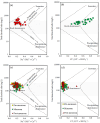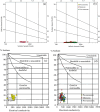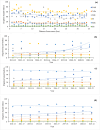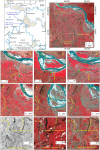Hydro-chemical characterization and irrigation suitability assessment of a tropical decaying river in India
- PMID: 39209950
- PMCID: PMC11362304
- DOI: 10.1038/s41598-024-70851-3
Hydro-chemical characterization and irrigation suitability assessment of a tropical decaying river in India
Abstract
Water pollution is a major concern for a decaying river. Polluted water reduces ecosystem services and human use of rivers. Therefore, the present study aims to assess the irrigation suitability of the Jalangi River water. A total of 34 pre-selected water samples were gathered from the source to the sink of the Jalangi River with an interval of 10 km and one secondary station's data from February 2012 to January 2022 were used for this purpose. The Piper diagram exhibits that the Jalangi River water is Na+-HCO3- types, and the alkaline earth (Ca2+ + Mg2+) outperforms alkalises (Na+ + K+) and weak acids (HCO3- + CO32-) outperform strong acids (Cl- + SO42-). SAR values ranging from 0.35 to 0.64 show that water is suitable for irrigation and poses no sodicity risks. The %Na results show that 91.18% of water samples are good and acceptable for irrigation. RSC levels indicate a significant alkalinity hazard, with 94.12% of samples considered inappropriate for irrigation. PI findings show that 91.18% of water samples are suitable for irrigation. Apart from the spatial water samples, seasonal water samples exhibit a wide variations as per the nature of irrigation hazards. Gibbs plot demonstrates that the weathering of rocks determined the hydro-chemical evolution of Jalangi River water. This study identifies very little evaporation dominance for pre- and post-monsoon water. The analysis of variance (ANOVA) test illustrates that there are no spatial variations in water quality while seasonal variations are widely noted (p < 0.05). The results also revealed that river water for irrigation during monsoon is suitable compared to the pre-monsoon season. Anthropogenic interventions including riverbed agriculture, and the discharge of untreated sewage from urban areas are playing a crucial role in deteriorating the water quality of the river, which needs substantial attention from the various stakeholders in a participatory, and sustainable manner.
Keywords: Hierarchical cluster analysis; Irrigation hazards; Jalangi River; Monsoonal variation; Principal component analysis; River decay; Saturation index.
© 2024. The Author(s).
Conflict of interest statement
The authors declare no competing interests.
Figures









References
-
- Mahammad, S. & Islam, A. Surface water quality assessment for drinking and irrigation using DEMATEL, entropy-based models and irrigation hazard indices. Environ. Earth Sci.83(10), 332. 10.1007/s12665-024-11633-y (2024). 10.1007/s12665-024-11633-y - DOI
-
- Putri, R. F. et al. The impact of population pressure on agricultural land towards food sufficiency (Case in West Kalimantan Province, Indonesia). In IOP Conference Series: Earth and Environmental Science 012050 (IOP Publishing, 2019).
-
- Angelakιs, A. N. et al. Irrigation of world agricultural lands: Evolution through the millennia. Water12(5), 1285. 10.3390/w12051285 (2020). 10.3390/w12051285 - DOI
-
- Singh N, Singh OP. Green revolution in India and its impact on water resources. Millennium water story. https://millenniumwaterstory.org/Pages/Photostories/Water-and-Livelihood.... Accessed on 15 May 2024. (2021).
LinkOut - more resources
Full Text Sources
Research Materials
Miscellaneous

